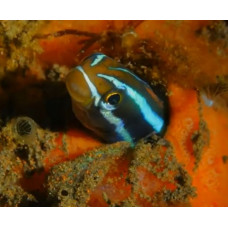Latin name
Plagiotremus rhinorhynchos
Other name
Plagiotremus rhinorhynchos
Identification
Bluestriped Fangblenny have the ability to change coloration and stripe patterns to hide among schools of fish from where they can attack passing fish.
Features of fish fins
Dorsal spines (total): 10-12; Dorsal soft rays (total): 31-37; Anal spines: 2; anal soft rays: 29-33.
Fish colouring
This fish has two distinct colors: blue with a black stripe from snout to tail, or orange with two narrow blue stripes from snout to tail.
Distribution
Indo-Pacific: Red Sea south to Naisna, South Africa and east to the line, Marquesas and Society Islands, north to southern Japan, south to Lord Howe Island. Replaced in Hawaii by Plagiotremus ewaensis.
Habitat
Marine subtropical species. Depth ranges from 1 to 40 meters. Adults inhabit clean, coral-rich areas of ocean-facing lagoons and reefs and are fairly common on both coral and rocky reefs.
Size
Bluestriped fangblenny can grow to about 12 cm in length.
Behavior
Bluestriped fangblennies hide in abandoned wormtubes or other small burrows, usually alone or in pairs. These fish serve as cleaners for larger host fish that oversee the removal of ectoparasites. They bite the host fish and leave. The opioid-containing venom helps them escape, as the bite does not cause pain, but dulls the host's response.
Food and feeding habits
They feed on the skin, mucus, and sometimes scales of other fish and are quick to attack.
Reproduction
Egg-laying, forming distinct pairs. Their eggs are benthic and adhesive, attached to the substrate by a fibrous adhesive pad or base. Larvae are planktonic, often inhabiting shallow coastal waters.
Fishing
This species is commercially important. The fish are caught for sale to aquariums.
Relationship with a person
Harmless. These fish are known to be aggressive. They will bite divers if disturbed.
| Classification | |
| Phylum | Chordata |
| Class | Actinopterygii |
| Squad | Blenniiformes |
| Family | Blenniidae |
| Genus | Plagiotremus |
| Species | P. rhinorhynchos |
| Features | |
| Conservation status | Least Concern |
| Habitat | Pelagic |
| Life span, years | No information |
| Maximum body weight, kg | No information |
| Maximum length, cm | 12 |
| Sailing speed, m/s | No information |
| Threat to people | Not edible |
| Way of eating | Planktonophage |
Bluestriped fangblenny
Tags: bluestriped fangblenny



